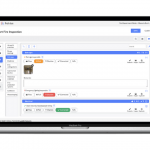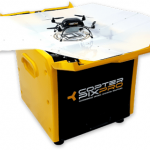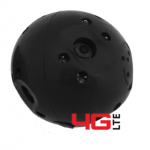Overview
Access points come in different flavors.
In the world of cybersecurity, an access point is a device that creates a wireless local area network, usually in an office or large building. An access point connects to a wired router, switch, or hub via an Ethernet cable, and projects a Wi-Fi signal to a designated area.
In the world of physical security, access points are the physical points of entry where people can enter or leave a building or secured area. These access points are often protected with turnstiles, gates or security doors.
In both cases, access points must be protected.
In the cyber world, businesses need to lock down these access points from attackers who try to install rogue wireless access points on your network without your knowledge. Similarly, access points in the physical world need to be locked down. That’s why facilities managers install those tall, sweeping revolving doors at high-end hotels, or the waist-high gates you need to pass through at an amusement park? More sophisticated access control systems track activity and keep unauthorized visitors out of business locations.
The lines between physical and cybersecurity are blurring and it goes beyond sharing some common vocabulary.
Organizations are realizing that cyber and physical assets can be targeted, separately or simultaneously, and compromised resulting in financial and data loss. Hacking into network systems is not the only way that sensitive information can be stolen or used against an organization. Physical security must be architected correctly to prevent attackers from gaining access. Afterall, firewalls, encryption and other network security measures can be rendered useless if a bad actor can physically access your network. In addition, today’s threats are often a result of hybrid attacks targeting both physical and cyber assets.
The commercial adoption and integration of Internet of Things (IoT) devices have only expanded the attack surface and further blurred the once delineated functions of cybersecurity and physical security.
This is where Access Point AI comes into play.
AnyVision’s Access Point AI platform leverages a number of state-of-the-art technologies including computer vision, machine learning, liveness detection and biometrics to help protect an organization’s physical access points. By identifying authorized personnel and persons of interest in real-time — whether VIPs or bad actors — modern enterprises can layer in additional operational insights to streamline the customer experience. Access Point AI is being used to optimize touchless access control, video surveillance, and watchlist alerting. This same platform will drive operational insights including occupancy analytics, people counting, and dwell times as well as flag potentially dangerous behavior.
Access Point AI also includes important privacy controls to protect the rights of data subjects. We have implanted several features such as anonymous processing (comparing mathematical vectors of faces and not the actual facial images to identify persons of interest), face-blur (the option to blur all the faces of individuals that were not enrolled to the watchlist), and privacy mode (the option to discard all detections of non-enrolled individuals). These features are designed to quickly apply advanced privacy settings, to collect only the data that is strictly necessary for the purposes of the processing (data minimization), and to automatically and selectively clear data from an active database at the end of a certain period, or to easily delete unused data.
Access Point AI is redefining the role of visual recognition within organizations. This state-of-the-art technology is being integrated with video chips and IP cameras to make security cameras and access control systems smarter by extracting valuable data from high-resolution video streams in real-time. Access Point AI enables low-power, high-resolution IP security cameras with features such as facial recognition, person detection, analytics and more.
Access Point AI is also fueling the move to the Edge. Our platform pushes more of this processing to the actual cameras and dramatically reduces the need for expensive, on-premise servers, fundamentally changing the historical paradigm for large-scale video security and biometric-based access control. The ability to perform real-time video analytics directly on cameras and within access control systems is a growing trend in the convergence of AI and IoT. The combination of AnyVision’s Access Point AI software and edge computing will enable smarter AIoT devices for the next generation of security and access control systems.
The promise of Access Point AI starts to gain real traction as more and more of compute processing moves to the edge. What this will allow us to do is better protect the anonymity of bystanders who come into the camera’s field of view. Because the video data is stored locally on the edge device, AnyVision will only transmit the images of individuals who are matched to the organization’s watchlist to their central servers or Cloud. This protects the privacy of all other non-watchlist people and minimizes the attack surface since only POI data is transmitted back to the network.
We’re just at the beginning of this journey, but the evolution of Access Point AI offers the promise to reimagine physical security. As we continue to train our models, we’re learning more and more about how AI can benefit – and redefine — security and create new opportunities for everything from intelligent threat detection, touchless access control, watchlist alerting to personalized customer experiences.
Details
End users are viewing your products!
Make sure they have all the information they need.
If you own this product, sign in to complete this sectionImages
End users are viewing your products!
Make sure they have all the information they need.
If you own this product, sign in to complete this sectionVideos

Sorry, you must be logged in to view the rest of this page
Please log in or create an account to view more details.
Log in or Sign UpCustomers and Partners
Documents

Sorry, you must be logged in to view the rest of this page
Please log in or create an account to view more details.
Log in or Sign UpExpert Analysis

Sorry, you must be logged in to view the rest of this page
Please log in or create an account to view more details.
Log in or Sign Up








